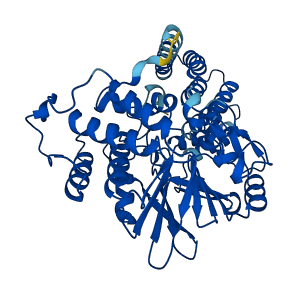O43049
Gene name |
ppt1 |
Protein name |
Serine/threonine-protein phosphatase T |
Names |
PPT |
Species |
Schizosaccharomyces pombe (strain 972 / ATCC 24843) (Fission yeast) |
KEGG Pathway |
spo:SPBC3F6.01c |
EC number |
3.1.3.16: Phosphoric monoester hydrolases |
Protein Class |
|

Descriptions
(Annotation from UniProt)
The TPR repeats mediate protein-protein interactions with substrate proteins, but also autoinhibit PPT phosphatase activity.
Autoinhibitory domains (AIDs)
Target domain |
179-456 (Phosphatase domain) |
Relief mechanism |
|
Assay |
|
Accessory elements
No accessory elements
References
Autoinhibited structure

Activated structure

1 structures for O43049
| Entry ID | Method | Resolution | Chain | Position | Source |
|---|---|---|---|---|---|
| AF-O43049-F1 | Predicted | AlphaFoldDB |
No variants for O43049
| Variant ID(s) | Position | Change | Description | Diseaes Association | Provenance |
|---|---|---|---|---|---|
| No variants for O43049 | |||||
No associated diseases with O43049
7 regional properties for O43049
| Type | Name | Position | InterPro Accession |
|---|---|---|---|
| domain | Calcineurin-like phosphoesterase domain, ApaH type | 212 - 406 | IPR004843 |
| domain | Serine/threonine-specific protein phosphatase/bis(5-nucleosyl)-tetraphosphatase | 179 - 456 | IPR006186 |
| domain | PPP domain | 113 - 203 | IPR013235 |
| repeat | Tetratricopeptide repeat | 5 - 38 | IPR019734-1 |
| repeat | Tetratricopeptide repeat | 39 - 72 | IPR019734-2 |
| repeat | Tetratricopeptide repeat | 73 - 106 | IPR019734-3 |
| domain | PP5, C-terminal metallophosphatase domain | 152 - 467 | IPR041753 |
Functions
| Description | ||
|---|---|---|
| EC Number | 3.1.3.16 | Phosphoric monoester hydrolases |
| Subcellular Localization |
|
|
| PANTHER Family | ||
| PANTHER Subfamily | ||
| PANTHER Protein Class | ||
| PANTHER Pathway Category | No pathway information available | |
2 GO annotations of cellular component
| Name | Definition |
|---|---|
| cytosol | The part of the cytoplasm that does not contain organelles but which does contain other particulate matter, such as protein complexes. |
| nucleus | A membrane-bounded organelle of eukaryotic cells in which chromosomes are housed and replicated. In most cells, the nucleus contains all of the cell's chromosomes except the organellar chromosomes, and is the site of RNA synthesis and processing. In some species, or in specialized cell types, RNA metabolism or DNA replication may be absent. |
2 GO annotations of molecular function
| Name | Definition |
|---|---|
| metal ion binding | Binding to a metal ion. |
| protein serine/threonine phosphatase activity | Catalysis of the reaction: protein serine phosphate + H2O = protein serine + phosphate, and protein threonine phosphate + H2O = protein threonine + phosphate. |
1 GO annotations of biological process
| Name | Definition |
|---|---|
| signal transduction | The cellular process in which a signal is conveyed to trigger a change in the activity or state of a cell. Signal transduction begins with reception of a signal (e.g. a ligand binding to a receptor or receptor activation by a stimulus such as light), or for signal transduction in the absence of ligand, signal-withdrawal or the activity of a constitutively active receptor. Signal transduction ends with regulation of a downstream cellular process, e.g. regulation of transcription or regulation of a metabolic process. Signal transduction covers signaling from receptors located on the surface of the cell and signaling via molecules located within the cell. For signaling between cells, signal transduction is restricted to events at and within the receiving cell. |
No homologous proteins in AiPD
| UniProt AC | Gene Name | Protein Name | Species | Evidence Code |
|---|---|---|---|---|
| No homologous proteins | ||||
| 10 | 20 | 30 | 40 | 50 | 60 |
| MAKEALELKN | EANKFLKEGH | IVQAIDLYTK | AIELDSTNAI | LYSNRSLAHL | KSEDYGLAIN |
| 70 | 80 | 90 | 100 | 110 | 120 |
| DASKAIECDP | EYAKAYFRRA | TAHIAIFQPK | EAVGDFRKAL | ALAPSDPAAR | KKLRECEQLV |
| 130 | 140 | 150 | 160 | 170 | 180 |
| KRIRFQEAIH | NTEPPSPLAN | INIEDMDIPS | DYDGVILEKQ | ITKEFVEDMK | ERFCQGKKLP |
| 190 | 200 | 210 | 220 | 230 | 240 |
| LKFAYSILRD | LKELLEKTPS | LIDIPVKGDE | TLVICGDTHG | QYFDLLNIFK | LHGPPSPTNK |
| 250 | 260 | 270 | 280 | 290 | 300 |
| YLFNGDFVDR | GSWSTEVAFT | LYAYKLLYPD | AVFINRGNHE | TDDMNKVYGF | EGECRSKYNE |
| 310 | 320 | 330 | 340 | 350 | 360 |
| RTFNIFSETF | SLLPLGSLIS | DSYLVVHGGL | FSDDNVTLDQ | LRNIDRFSKK | QPGQSGLMME |
| 370 | 380 | 390 | 400 | 410 | 420 |
| MLWTDPQPAP | GRGPSKRGVG | LQFGPDVSKR | FCEANGLKAV | IRSHEVRDQG | YEVEHDGYCI |
| 430 | 440 | 450 | 460 | 470 | |
| TVFSAPNYCD | STGNLGAVIK | VKEDMELDFH | QFEAVPHPNI | RPMAYANGLL | SGM |